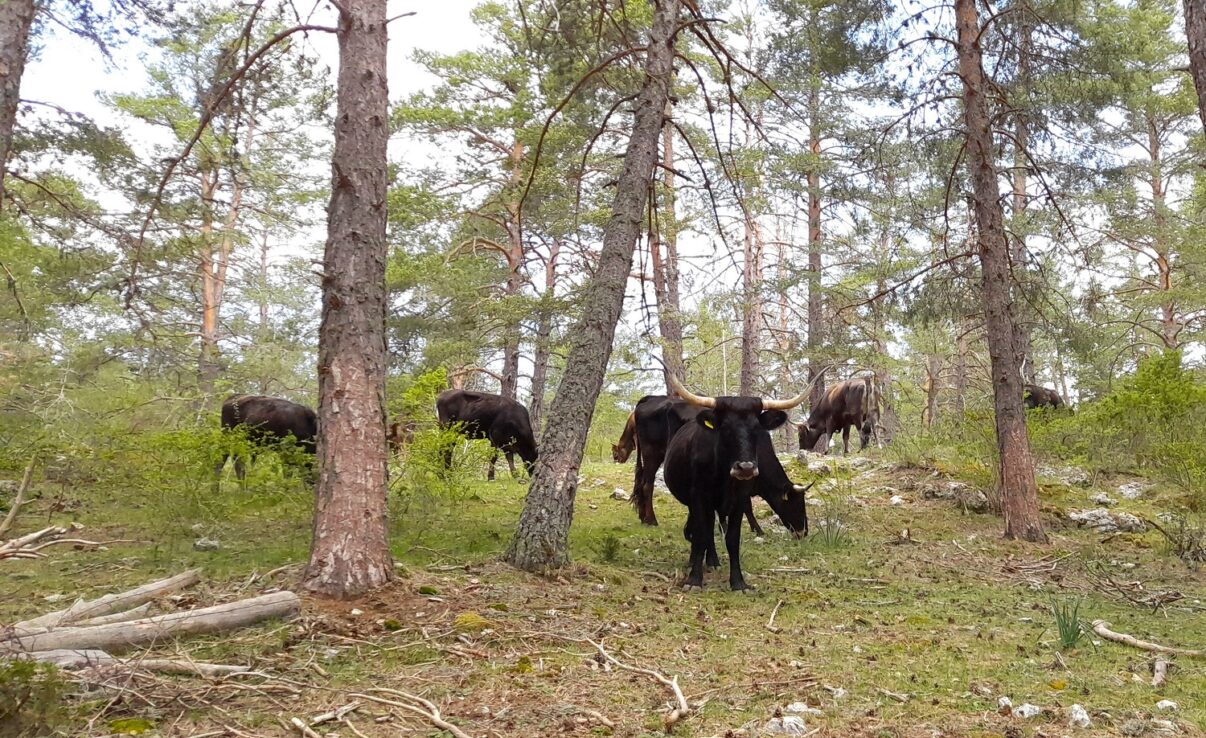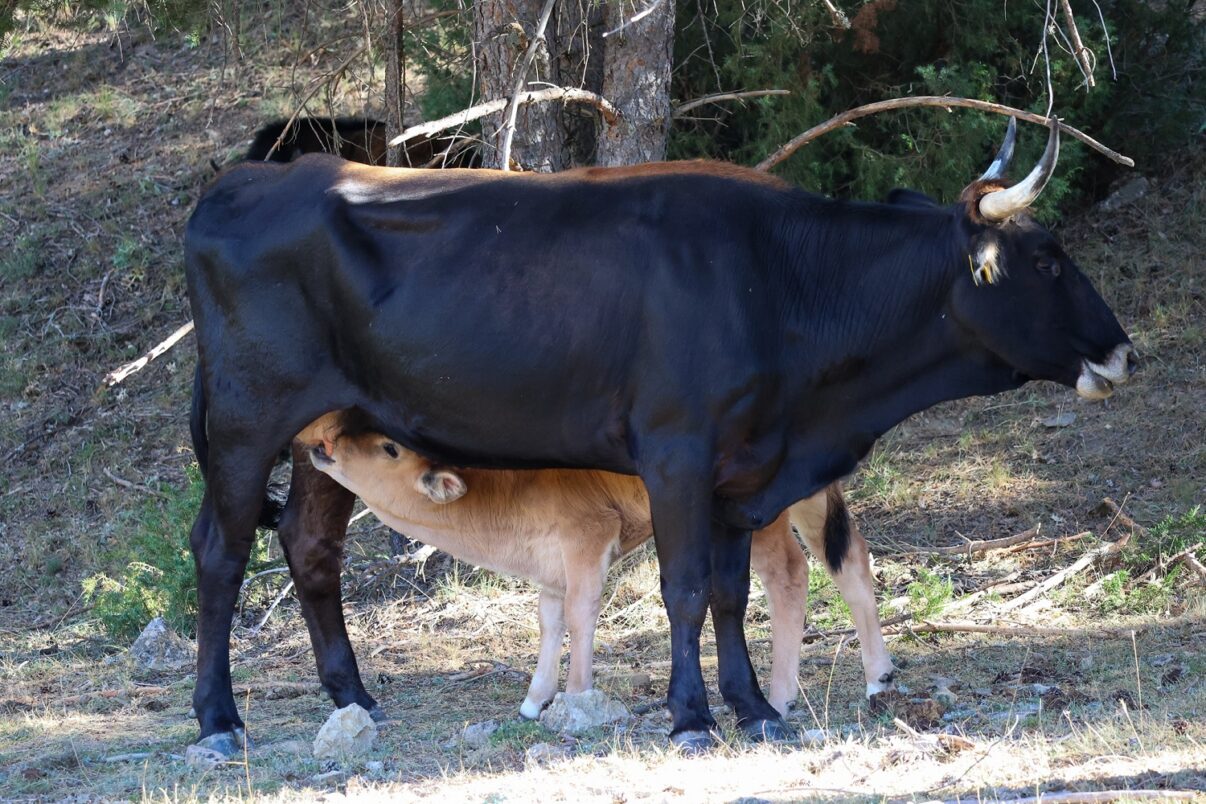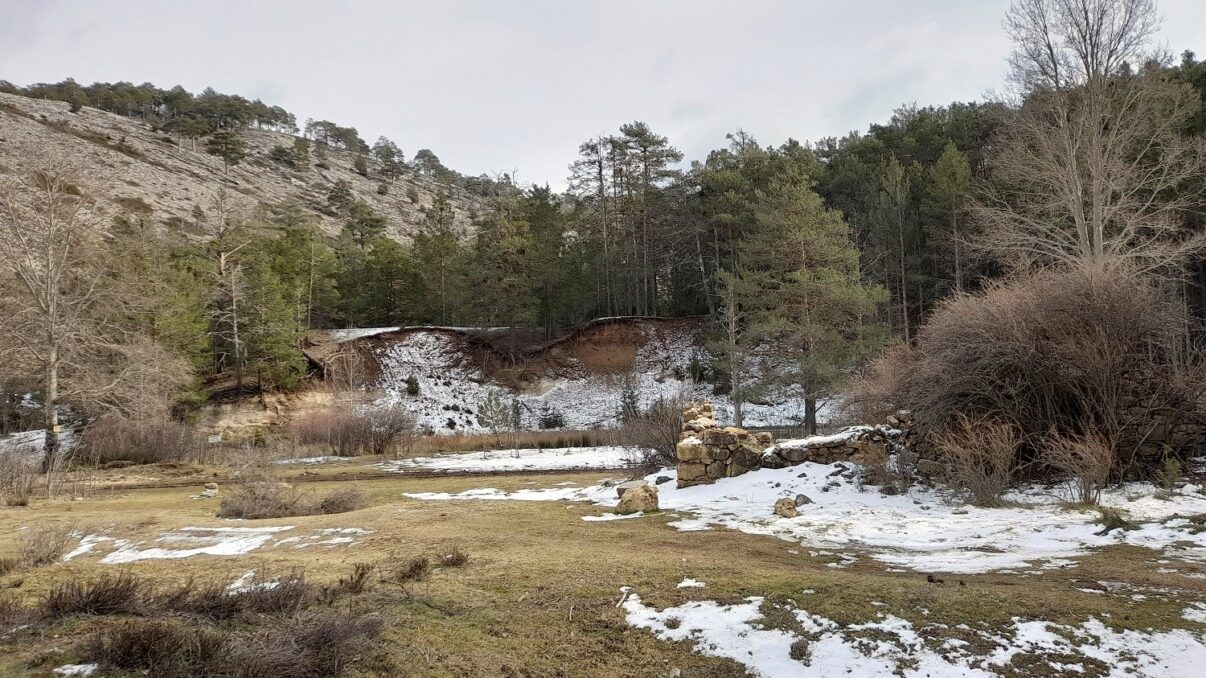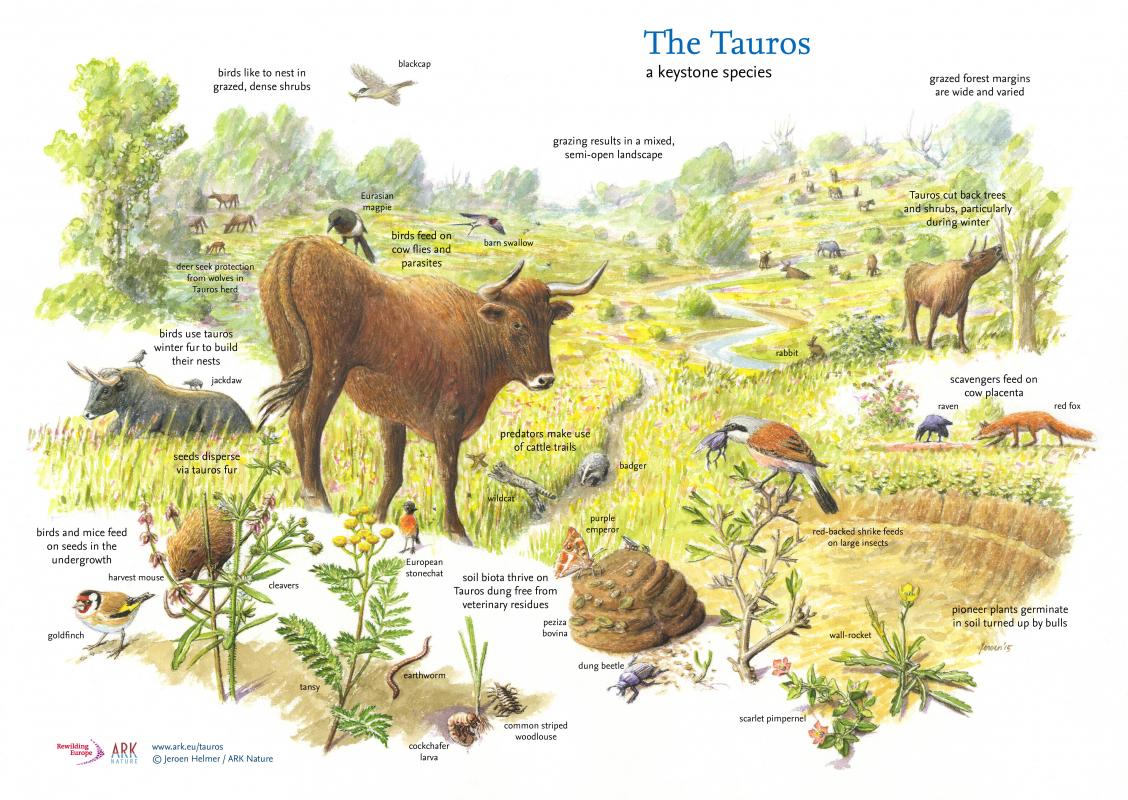Ricardo Almazán is the general manager of La Maleza Wildlife Park, located in Sierra de Albarracín region. With the support of Rewilding Europe, his business committed in 2021 to making this area the first place in Spain to host a herd of tauros, the bovids that gather the features of the aurochs, the extinct wild cow. In this post Ricardo describes his experience with these awesome animals and how the effects of their presence in the landscape are already becoming visible.

Around 800,000 years ago a large wild bovine roamed the Iberian Peninsula: the aurochs (bos primigenius primigenius). It inhabited all of Europe and part of Asia. It is the ancestor of all the domestic cattle breeds known nowadays, an imposing animal weighing one tonne, which the great climatic changes of prehistoric times and human pressure forced to retreat until its total disappearance. The last aurochs died in Poland in 1627.
The tauro is a large bovine that has come to fill the ecological niche left by the extintion of the aurochs. This animal shares 94% of its genetics with the aurochs. This was made possible by the work of Stichting Taurus Dutch foundation, which managed to obtain the genetic sequence of auroch and, knowing that today’s bovines are descended from this species, combined genetic material from breeds that have remained relatively close genetically to their ancestor. Some of these breeds are Spanish, such as the Galician limiana, the Cantabrian tudanca, the Zamoran sayaguesa and the southern pajuna.
Once selected for their genetic proximity, specimens were crossed with the aim of obtaining an animal that was as similar as possible to that imposing wild bovine: thus the tauro was born. And this kind of aurochs 2.0 has come back to life to help us recover ecosystems.
Most of us have recently begun to understand the role of large carnivores as keystone species, without them ecosystems are unable to function properly. We may not accept it, but we know it. What about the large herbivores? Well, without them, nothing can function either.
At present time, we have serious problem with scrub in our forests. Forests are closing up and becoming impassable even for the wild ungulates of the landscape; these are lands where the light no longer reaches the ground and where the seeds cannot germinate. Thousands of trees are born but will not thrive because of the high density. We have fuel-filled hills where, when wildfire breaks out, thousands of hectares might inevitably burn. All these problems are caused by the lack of large herbivores and, luckily the tauro comes to solve them willingly.
Like its predecessor, the tauro has a great capacity to digest cellulose, which allows it to feed on highly lignified plants (which have the texture of wood) such as bushes, branches and small trees.

It is a huge animal that weighs around – and even exceeds – a thousand kilos and has a great capacity for ingestion, so it removes a lot of vegetation from the bush, more than other species, as well as eating a specific type of vegetation that other animals cannot digest. On the other hand, its large size and strength mean that, as it passes through, it is capable of crossing enclosed areas of vegetation that trampled, crushed and broken, thus opening the way to other animals and, above all, to sunlight. Also, because of its unusual size, it generates large quantities of faeces, which brings life back to the soil. These are not only abundant but, most importantly, drug-free, as the tauro is such a strong animal that it does not receive anti-parasitic treatments, unlike domestic cattle.
The drugs given to other animals cause their faeces to kill the soil fauna. However, the tauro is more than capable of living with its internal parasites, maintaining a correct balance on its own without the need for human intervention and medication. In short, it is an animal that, by its way of life and the way it feeds, can restore biodiversity to the place it inhabits. It benefits plants, which obtain more light and nutrients; it restores mosaic landscapes; it gives life to soil fauna; it increases available meadows for the wild herbivores that cohabit in the area; it opens up paths in forests… It is a key species that must once again inhabit our territories.
Ancestral behaviours
In addition to its unique way of feeding, the tauro also exhibits behaviours that have little to do with its domestic relatives. This animal was born to be wild and knows how to be wild. A bovine that is becoming undomesticated. Thus, the taurus displays ancestral behaviours, which are fundamental for its survival in the wild, without the help of man.
Their herds are perfectly structured and always maintain the unity of the group, as opposed to the trend to dispersion of the domestic relatives; this provides protection. As well, it is a matriarchal species, as the whole group follows the leadership of one of the adult females. Moreover, it has been found that some matriarchs choose to share this position of hierarchy with one or two other females, so that it is possible to find herds with one, two or even three female leaders. Large males weighing 1,000 or 1,200 kg, small males, females without leadership qualities and adolescents will all abide by this leadership.

Surprisingly, tauros also exhibit a behaviour which is more typical of that of some large carnivores. When a male reaches sexual maturity and aspires to be the leader, but knows that he will not be able to occupy that position in his current herd, he will separate from his own and look for a new group in another territory. In a world where man had not wiped out these large herbivores, he would meet other individuals and a new family would be created.
As wee, when a large predator like the wolf stalks the pack, the strongest adults form a circle, and the weakest and youngest stay in the centre. The wolves, faced with a group of adults showing their horns to the outside, will have no choice but to look for food elsewhere.
Their behaviour towards their young specimens is also fascinating. The newborns are hidden by their mothers for days among the vegetation to protect them. When spring arrives and the births are concentrated, one of the females will remain guarding the group of hidden calves while the others go with the rest of the herd and feed, look for water or just rest. The vigilant female will not only protect them, but will also act as a wet nurse and feed anyone who needs it. An impressive animal that brings back the behaviours that made its ancestor live on Earth for thousands of years.
The herd of tauros at Sierra de Albarracín arrived at Spain from The Netherlands in 2021 and was the first in our country. It was made up of three adult females, a huge stallion, eight one-year-old heifers and seven steers of the same age. They inhabit a 500 hectare pine forest located in Frías de Albarracín, Calomarde and Albarracín area. Despite the big change of scenery, the adaptation was quick, comfortable and uneventful. Today, the herd it is made up of almost thirty specimens.
Visible changes in the landscape
The transforming effect of this animal on the forests of these mountains is already a visible reality. The coarse grasses of the sunny areas are becoming fresh and appetizing pastures; the strong, dense and tall rockroses are not that high and dense anymore, which favours the meadow; small pines of ridiculous diameters, separated by just a few centimetres, which were trying to grow towards the sun, fall by the dozens due to the action of these huge cattle, letting the sunlight reach the ground and giving opportunities again to oak trees, junipers…
The headwaters of the Blanco river, where the water had difficulty crossing the dense aquatic and riverbank vegetation, are now clean and clear, leaving the crystalline waters visible, and the meanders are recovering another route, probably more similar to the existing one when large herbivores grazed there.

These changes are having another interesting effect: the fallow deers, roe deers, red deers and Iberian ibex that also inhabit the area are concentrating around the tauros. They have realised that, next to these huge neighbours, the food is more palatable, finer and more plentiful. Thus, a large core of biodiversity forms spontaneously.
Beneath them all grows the soil fauna that the tauros are helping to regenerate. And above them, birds also gather, as they are benefiting from the new life in the soil and from the parasites they pick up from the tauros fur. The scavengers will also find a great feast the day that one of these imposing animals reaches the end of its journey… Life is revived by the arrival of a major player who has been missing for too long.
Will this concentration of herbivores be able, in time, to attract other species that are still missing from the equation? The wolf would choose, if we let it, a place like this. And if it finally arrives, we will have an area where the trophic chain will be fully functional again, thus mending the consequences of such serious human-generated absences.
My message to potential detractors is that, in the end, we are talking about super-extensive livestock farming with a bovine that is so unique that it can also generate admiration. And that admiration will make many people want to get to know it closely; this can bring us, in addition to the environmental benefit, an economic benefit based on responsible and respectful nature tourism.
And for those who advocate for achieving the same effects on the landscape with domestic, rustic and native cattle, well, these animal are also welcome! There is no doubt about the benefits of recovering these breeds, nor about their capacity to sustain the natural environment they inhabit; and they can provide also wealth in the area. But only the tauro is capable of spending the whole year without additional food or transhumance, and it is in the harsh winter when it is forced to cut down the bushes, eating branches or small trees. It is then that this incredible animal displays its very much needed differentiating capabilities.
Future of tauros
Desde el Parque La Maleza seguiremos trabajando por el bienestar del tauro, con la colaboración y el apoyo técnico y económico de Rewilding Spain. Pero hace falta otro par de empujones más. Uno depende de cada uno de nosotros, que tenemos que abrirnos a conocerlo de cerca, a entender que no es un animal peligroso y a apreciar todo el valor que aporta a nuestros espacios naturales y a nuestras comunidades.

La Maleza Wildlife Park will keep on working in tauros wellbeing, also with the technical and financial support from Rewilding Spain. But we need a couple more pushes. One depends on each one of us, who have the chance to get to know tauro closely, to understand that it is not a dangerous animal and to appreciate all the value it brings to wildlife and to our communities.
A second push should come from the legal side. Tauro is currently considered a domestic animal, which therefore has to inhabit a defined area and periodically undergo health interventions that, in reality, it does not need for survival, nor make much sense given that its role is purely ecological, not productive. Current legislation puts barriers in the way of a free soul that knows where it has to go, when and why. These laws must change as soon as possible and end up recognising this auroch 2.0 as a wild animal.